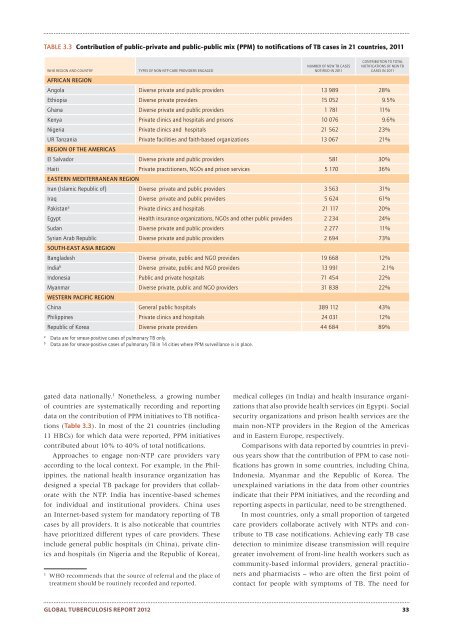Global Tuberculosis Report -- 2012.pdf
Global Tuberculosis Report -- 2012.pdf
Global Tuberculosis Report -- 2012.pdf
You also want an ePaper? Increase the reach of your titles
YUMPU automatically turns print PDFs into web optimized ePapers that Google loves.
TABLE 3.3 Contribution of public–private and public–public mix (PPM) to notifications of TB cases in 21 countries, 2011WHO REGION AND COUNTRYTYPES OF NON-NTP CARE PROVIDERS ENGAGEDNUMBER OF NEW TB CASESNOTIFIED IN 2011CONTRIBUTION TO TOTALNOTIFICATIONS OF NEW TBCASES IN 2011AFRICAN REGIONAngola Diverse private and public providers 13 989 28%Ethiopia Diverse private providers 15 052 9.5%Ghana Diverse private and public providers 1 781 11%Kenya Private clinics and hospitals and prisons 10 076 9.6%Nigeria Private clinics and hospitals 21 562 23%UR Tanzania Private facilities and faith-based organizations 13 067 21%REGION OF THE AMERICASEl Salvador Diverse private and public providers 581 30%Haiti Private practitioners, NGOs and prison services 5 170 36%EASTERN MEDITERRANEAN REGIONIran (Islamic Republic of) Diverse private and public providers 3 563 31%Iraq Diverse private and public providers 5 624 61%Pakistan a Private clinics and hospitals 21 117 20%Egypt Health insurance organizations, NGOs and other public providers 2 234 24%Sudan Diverse private and public providers 2 277 11%Syrian Arab Republic Diverse private and public providers 2 694 73%SOUTH-EAST ASIA REGIONBangladesh Diverse private, public and NGO providers 19 668 12%India b Diverse private, public and NGO providers 13 991 2.1%Indonesia Public and private hospitals 71 454 22%Myanmar Diverse private, public and NGO providers 31 838 22%WESTERN PACIFIC REGIONChina General public hospitals 389 112 43%Philippines Private clinics and hospitals 24 031 12%Republic of Korea Diverse private providers 44 684 89%aData are for smear-positive cases of pulmonary TB only.bData are for smear-positive cases of pulmonary TB in 14 cities where PPM surveillance is in place.gated data nationally. 1 Nonetheless, a growing numberof countries are systematically recording and reportingdata on the contribution of PPM initiatives to TB notifications(Table 3.3). In most of the 21 countries (including11 HBCs) for which data were reported, PPM initiativescontributed about 10% to 40% of total notifications.Approaches to engage non-NTP care providers varyaccording to the local context. For example, in the Philippines,the national health insurance organization hasdesigned a special TB package for providers that collaboratewith the NTP. India has incentive-based schemesfor individual and institutional providers. China usesan Internet-based system for mandatory reporting of TBcases by all providers. It is also noticeable that countrieshave prioritized different types of care providers. Theseinclude general public hospitals (in China), private clinicsand hospitals (in Nigeria and the Republic of Korea),1WHO recommends that the source of referral and the place oftreatment should be routinely recorded and reported.medical colleges (in India) and health insurance organizationsthat also provide health services (in Egypt). Socialsecurity organizations and prison health services are themain non-NTP providers in the Region of the Americasand in Eastern Europe, respectively.Comparisons with data reported by countries in previousyears show that the contribution of PPM to case notificationshas grown in some countries, including China,Indonesia, Myanmar and the Republic of Korea. Theunexplained variations in the data from other countriesindicate that their PPM initiatives, and the recording andreporting aspects in particular, need to be strengthened.In most countries, only a small proportion of targetedcare providers collaborate actively with NTPs and contributeto TB case notifications. Achieving early TB casedetection to minimize disease transmission will requiregreater involvement of front-line health workers such ascommunity-based informal providers, general practitionersand pharmacists – who are often the first point ofcontact for people with symptoms of TB. The need forGLOBAL TUBERCULOSIS REPORT 2012 33
















